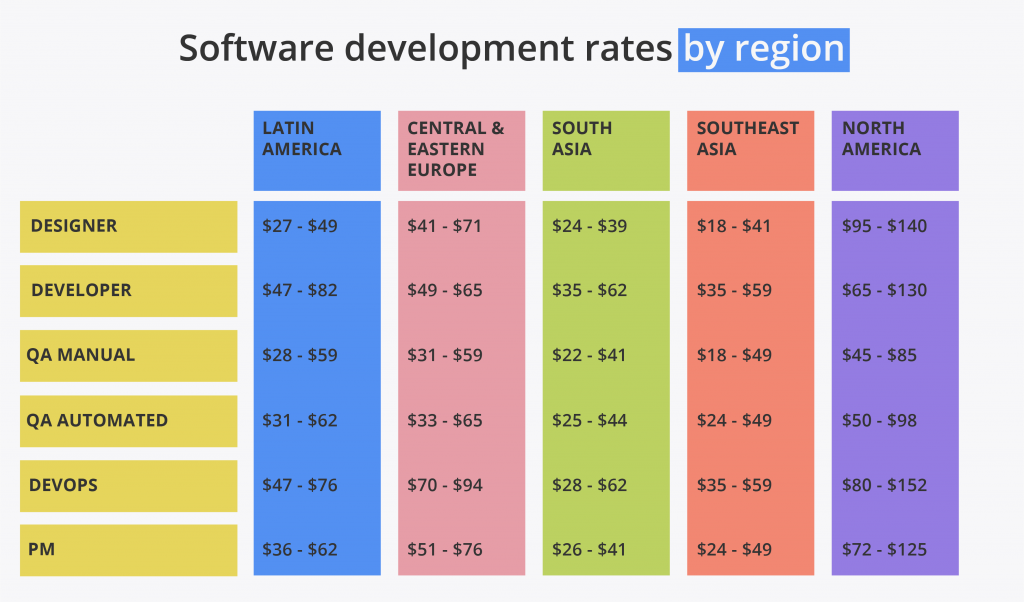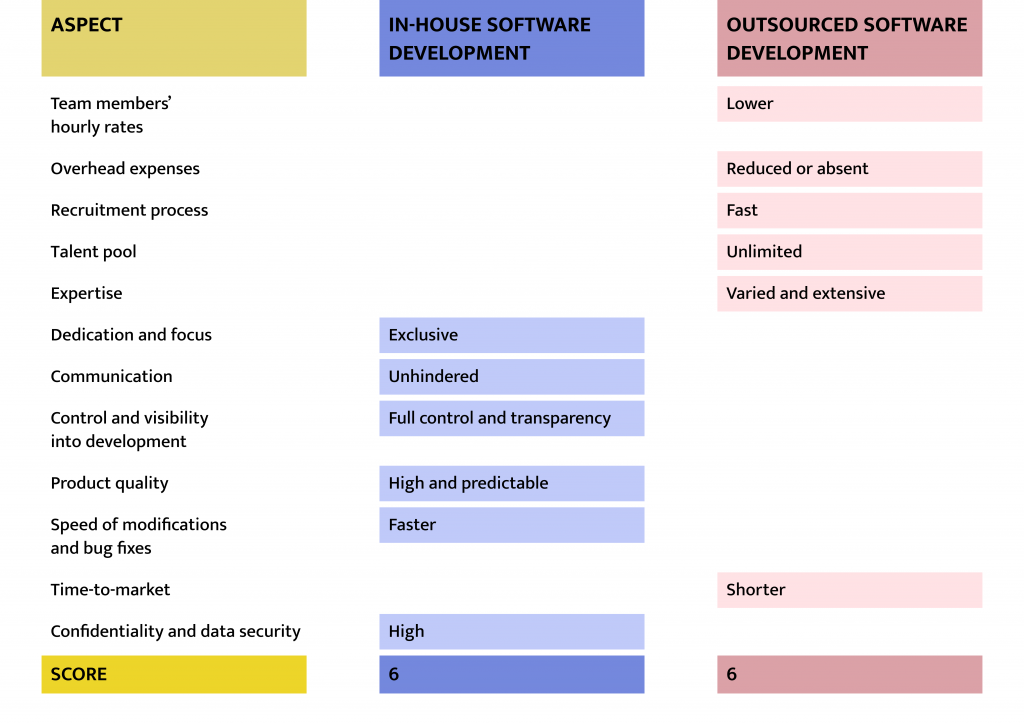In-House Software Development vs Outsourcing: What’s Your Choice?

Every startup or enterprise undergoing a digital transformation is bound to face the dilemma of building their product in-house vs outsourcing software development to external organizations.
As more and more startups and established, international companies outsource their IT needs to countries like Poland, Ukraine, or Romania, it may be tempting to follow suit. However, before going one way or another, it’s essential to understand both the advantages and risks associated with each choice.
This article offers an analysis of both strategies that can hopefully help you make an informed decision. If, upon reading, you decide that offshore outsourcing is what you need, please feel free to check out Alternative-spaces’ services and some of our projects.
Let’s start our in-house development vs outsourcing comparison with a detailed description of the first option.
In-house Software Development: Definition, Pros, and Cons
In-house software development is the business practice and process of building a digital product relying exclusively on a corporate entity’s employees and expertise available internally. If there is no IT department, the entity has to build its in-house team from scratch, finding and employing personnel necessary for developing the product.
It is often assumed that in-house developed software is intended exclusively for organizational usage. This is not correct. For example, along with Amazon and PayPal, the iconic software-as-a-service Salesforce relies on in-house developers to build and enhance its product. This is no surprise, given the many advantages of in-house development.
The advantages of in-house software development
Full control. An in-house team allows the business management full ownership and control over each aspect of the product. They enjoy total visibility over the day-to-day progress and what the employees are doing, and can react promptly to any request or issue.
Convenience. Everyone can meet face to face and speak to any team member at an office during working hours or even after. There is no need for emails, let alone travel, to share information across the organization.
Smooth communication. In-house development implies regular, comfortable direct communication. The management deals with trusted people who understand the corporate culture and business specifics. Team members hired locally also have similar cultural and language backgrounds. This promotes seamless communication, a shared product vision, thorough understanding of the project requirements, cooperation, and fast feedback. Face-to-face conversations help avoid misunderstanding and minimize the turnaround time.
Deep involvement. A team that is focused on one shared goal is more likely to achieve it. Being employed by the company, belonging to the team, and working for it daily, in-house software engineers tend to be deeply involved and immersed in the project. They are committed, focused on quality, and motivated to achieve the best results and bring as much value as possible for the company. They may also know some internal levers and strings they can use to achieve the result or to customize the software engineering process as needed.
Flexibility for the product. With total transparency, control over the employees’ work, and easy communication, the owner can request and make changes and get feedback whenever they wish to adjust the product or its development to their business needs. They can investigate issues immediately and promptly apply the fixes.
Alignment with the company. Recruiting your in-house development team, you have the opportunity to select people that align with the company’s core values and have the soft skills and personal qualities that will facilitate their onboarding, teamwork, and productivity in a more harmonious working environment. These developers will quickly adopt your company’s existing culture, and a permanent team will help develop a stable workflow and corporate ethics and culture for a startup faster.
Building the expertise. Employees constantly working on a project perfect their skills and domain knowledge, which gradually speeds up product development and reduces errors. All expertise gained during the project, including management skills, stays with the company.
Continuity. You will always have people familiar with the project specifics, challenges, and technical details from start to finish. More experienced and skilled team members can guide, train, and even manage others. In-house software development also promotes better control over the company’s coding standards and facilitates future product maintenance.
Unlimited post-delivery support. An in-house team stays dedicated to the project and is always available for further maintenance, bug fixes, updates, and improvements.
Enhanced security. All business data and know-how are kept within the organization, reducing the risk of information leakage or intellectual property theft.
Compatibility. Sometimes, only in-house developed software can meet the internal standards, perform a specific task, or allow enough customization and efficiency a business requires.

However, the benefits of in-house software development come with a twist – considerable investments in time, money, and effort. Let’s break them down.
The disadvantages of in-house development
Limited expertise. You can’t possibly gather in your team all the skills and competencies your software development process may require. When the project evolves, you may have to hire new resources urgently or invest in additional training of existing employees. The growing demand for experienced tech specialists makes it even harder to find the required talent in your area.
Lengthy hiring and onboarding processes. Depending on your project complexity, you may need at least three specialists to get started. Still, usually, it involves front-end and back-end developers, UX/UI designers, quality assurance engineers, Scrum masters or project managers (PMs), and others. Hiring a person to fill one role encompasses job advertising, reviewing CVs, screenings, interviews, and background assessment. The task is especially tricky if your core business is not related to software development or your startup has no HR department yet. Afterward, new hires will require time to get familiar with colleagues and the company’s processes and standards and possibly get additional training. This may take from 30 days to an astounding three months.
Difficult recruitment. The task of finding and recruiting every specialist is complicated by competition with other companies, especially if you are short on time and money. You need to offer higher wages and better conditions to attract qualified candidates. Moreover, even after all the work and costs, a new hire may fail to work out.
High salaries to pay. For example,as of November 2021, most software developer salaries in the US range between $68K and $100K a year. The average hourly rate is approximately $42/hour. That does not include the hidden cost of vacations, paid sick leaves, insurance, social security, and other benefits. But even this won’t guarantee your developers don’t leave mid-project: without keeping their salaries on par with the market rates, you risk losing valuable team members to competitors or recruiters at any moment.
Extra expenses. In the US, the average cost of hiring a new developer ranges between $4K and $7K. Don’t forget about each team member’s onboarding, employee training, taxes, software licenses and hardware, corporate events, and personnel management. Unless you’re an advocate of an all-remote model, you will also need to pay office rent and maintenance, equipment and furniture, snacks and beverages for the kitchen space, and other administrative costs. You will also periodically have to invest in new tools and training to keep up with the market. All these hidden costs can significantly affect the bottom line of your business.
Inefficient use of resources. You have to provide permanent staff with full-time work all year round. When they have no tasks or idle time between projects, you still have to pay their fixed salaries. When you invest in training employees who leave soon after, your money is wasted, and you’ll have to invest in new employees’ recruitment, onboarding, and training again.
The human factor. Every delay, failure in the recruitment process, or quitting team members can halt or slow down your website or app development or even threaten a live product’s stable operation.
So far, the advantages of in-house software development may seem to outweigh the disadvantages. However, the choice largely depends on each organization’s unique business goals and conditions.
When would in-house development work best?
You may benefit from the in-house development approach in the following cases:
- You already have an in-house team of product developers.
- If your startup strictly focuses on an IT product, building an in-house development team is a viable strategy.
- You are not a bootstrapped startup and have plenty of time, financial, and management resources at your disposal.
- If upon release you expect to have significant post-delivery work or similar long-time projects, it’s worthwhile to employ and keep software developers in-house.
- If you are an IT service company and want profound expertise and niche experience on your company’s profile, it’s essential to keep and grow your own team of product developers.
- Your digital product development or provision of your service requires a long-term commitment.
- Suppose you often require quick feature modifications, can’t afford the risks of bugs popping up, or an issue not resolved immediately can entail irreparable damage. In that case, you need your own team of software engineers that are always on hand and know the software inside out.
- You may also prefer hiring an in-house team if you prioritize comfortable and transparent communication, loyalty, and building a company culture.
Experience in tech talent recruitment or help from a recruitment agency are prerequisites for the successful hiring of an in-house team. It is crucial to understand what skill set is needed and how many team members will suffice to build the product. You also need to realistically assess the company’s financial status to make wise business decisions and plan the payroll.
Let’s consider the pros and cons of the alternative approach.
The Advantages and Challenges of Outsourced Software Development
Software outsourcing can be divided into nearshoring, onshoring, and offshoring, depending on where an entity farms out a software development project partially or entirely. It is usually delegated to an outsourced development agency or similar organization through a contractual agreement. Sometimes, several contractors may work on a project simultaneously.
There is no extended commitment: the external team is hired on a performance evaluation basis for a limited period. The cooperation is supposed to end once the product has been successfully delivered, although some outsourcing companies offer maintenance services when the same developers will maintain the product and fix errors and bugs.
Outsourced development has been an ever-growing trend. Some experts expect the IT services outsourcing market to grow at a CAGR of 4.5% and others – at 7.7% from 2021 to 2026. In this manner, the global IT outsourcing market estimated at $556.67 billion in 2020 should reach $937.67 billion by 2027.
Alibaba, Basecamp, GitHub, Google, MYSQL, Skype, and Slack are some of the big companies that have outsourced their software development needs. Let’s dive into the possible reasons.
The pros of outsourcing
Global talent pool. For starters, outsourcing is the simplest way to find the best professionals with specialized skill sets which they can’t find locally. As digital products are becoming increasingly diverse and sophisticated, outsourcing helps more companies cover their development and innovation needs. The IT outsourcing market is huge, so you can usually find an offer that fits your budget and competency requirements, including those in emerging technologies and narrow domains.
Deep technical expertise. Software development agencies recruit and train the best IT specialists who constantly prove and hone their skills and exchange knowledge on various projects. When you partner with these agencies, this talent and expertise become available to you. Often, it means working with niche experts whose deep knowledge of the domain can be priceless for young startups.
Paying less. Compared to the hourly rates of US-based software engineers, offshore and nearshore developers’ rates are considerably lower. Entrepreneurs can first select destinations with competitive rates and then – contractors with the best price/quality ratio. Eastern Europe is one of the top destinations, with vast and diverse workforce and low taxes. The developers’ salaries there are considerably lower than in North America or Western Europe for comparable expertise.

Flexibility with payments. Outsourcing converts fixed labor costs into variable costs: you only pay for the services you require and only for hours spent on your project. For example, a project can involve some specialists only for a short period, such as solutions architects, UX/UI experts, DevOps, admins, and others. You can quickly secure their help for only two weeks or two months. An outsourcing agency can provide both full-time and part-time workers to assist with particular tasks. If needed, you can request additional workforce or ask a senior programmer to spend extra hours on a task instead of hiring them full-time. Moreover, payment dates can be negotiated with the vendor, if necessary, whereas employees must be paid at the end of each month.
Reduced costs. You avoid the expenses inherent to in-house software development, such as HR overhead, payroll taxes, benefits, training expenses, office rent, equipment, etc.
Saved time and effort. Outsourcing takes away the exhausting recruitment. The outsourcing vendor has all the resources ready to build the required product. The hiring process is reduced from months to days when they assemble a team of vetted professionals based on your budget and technical requirements. You will also deal with less paperwork, sign fewer contracts, and send payments less frequently than with in-house employees.
Streamlined development process. A vendor’s team is typically experienced in handling development challenges and has access to the vast knowledge base accumulated by their company. Its members most likely have worked together on many projects. The vendor already has the necessary infrastructure and typically handles the management responsibilities as well. You also plug into established processes, with many of them already automated and refined according to best practices, such as DevOps and CI/CD. This enables you to jump-start the development process instead of spending time on inner collaboration and adaptation issues.
Rational use of resources. Working with an external team means freeing your in-house team from overload or enabling them to focus on the core tasks. You also get a managed group, which frees up your resources to focus on high-level business activities. The dedicated team model allows deep involvement in the development process. Alternatively, you can have your outsourcing partner take full responsibility for the development of your product.
Faster time-to-market. The time spent on hiring and staffing can be used for actual coding instead. Streamlined development processes and increased output will further accelerate the product’s time-to-market.
Competitive edge. Since outsourcing saves a lot of time and money, the company can develop its product at a lower price and launch it ahead of the competitors.
Scalability. It’s easy to scale an outsourced team up and down, depending on your needs. All people are replaceable. The vendor will provide the exact number of workers needed for each stage and task, adding the right specialists when required, providing substitutes, or removing idle workforce without firing anyone.
When is outsourcing better than in-house development?
- Outsourcing is suitable for startups without established development practices and for non-IT enterprises whose time and budget don’t allow building a large full-time IT department for its digital transformation needs.
- Outsourcing can be beneficial if you aren’t familiar with all the complexities of software development yet.
- When you operate in a region where local talent is scarce or comes at a premium cost.
- If you are an early-stage startup or operate on a tight budget and can’t afford a permanent team, office, and other related expenses.
- If you’re planning a midsize or large project while your in-house IT resources overwork.
- If the project you need developers for is not the company’s core business, it is better to farm out.
- Outsourcing works when you need to hand over one or more phases of a project or want to engage help on a short-term basis.
- It’s reasonable to entrust your business idea validation to an experienced outsourced development team instead of assembling one on your own. They can do it quickly and efficiently, potentially saving you a fortune in the long run.
If you envisioned an ambitious software project, but the requirements are far from being clear, it makes sense to rely on outsourcing agencies’ experience in product discovery and idea validation. Their PM can act as a business analyst and intermediary between the product owner and the developers.
Now, it’s fair to say that several true or perceived risks are associated with outsourcing.
The cons of outsourced software development
Search and negotiations. A trustworthy outsourcing partner and clear agreements are key, but it’s not always easy to find the right agency quickly. Moreover, both parties must agree on acknowledgment, pricing, meeting schedules, communication channels, and other matters to satisfy everyone’s needs and desires.
Possibility of a wrong choice.The main drawback of outsourcing is that a lot depends on your outsourcing partner. If you pick an unreliable company, you may get poor quality software, experience cost escalations, or even face the extreme consequences of hasty or ill-informed choices, such as:
- loss of confidential data
- failure to deliver the right product
- missed deadlines and wasted budget
- the contractor going out of business or simply disappearing with your money
Trust issues. It may seem terrifying to entrust crucial phases of your project and information to someone you’ve never met in person. You may worry that the burden of other clients’ requests and deadlines could prevent the contractor from 100% commitment to your project or writing solid code for you. You may also worry about their privacy policy and your ability to maintain the code without their involvement eventually.
Possible communication gaps. The PM is typically the main point of contact on a project, and most communication occurs by electronic means, such as email, Slack, or videoconferences. These tools, as good as they are, still are not the same as face-to-face conversations. Different time zones, cultural nuances, and limited English proficiency may further jeopardize communication with the partner and collaboration on the project. It may take a few hours to get a reply to an email, and bug fixes are generally not instant. If you’re outsourcing to a firm halfway across the globe, it will be hard to schedule a call at a time convenient for all.

Less control over the project. Since you’re not physically present during the development process, you might perceive a lack of control over the tasks being performed. The development process isn’t as transparent and easy to monitor as with in-house development. If something goes wrong, the time for solving the problem is longer than an in-house team would take.
Security risks. Sharing critical business information may pose some risks stemming from the human factor and insecure communication channels. To avoid that, choose a vendor with robust security practices and document security requirements in an NDA agreement. It should protect your project idea and any development processes and stimulate the procedure of data collection, transfer, access, and processing in compliance with the EU General Data Protection Regulation or other applicable laws.
Risk of low quality. Software engineers’ rates that are too low may be evidence that they are not well-qualified. Choosing vendors with the lowest prices is a very short-term saving that could likely backfire sooner than later. It’s better to focus on getting value for money. The vendor should develop your product according to agreed specifications, and you need to ensure you are on the same page regarding the acceptance criteria.
Luckily, with the right contractor, you can avoid these risks, overcome the challenges, and fully enjoy all the benefits of outsourcing.
Alternative-spaces: Your Reliable Outsourcing Partner
Alternative-spaces LLC is based in Eastern Europe and namely Ukraine, which abounds in highly qualified and talented software developers. The country’s IT services market entered 2021 with a 20% growth rate. About 85% of Ukraine’s 200,000 tech specialists have at least an intermediate English proficiency level. The outsourcing rates are extremely appealing, starting from $35 per hour.
Alternative-spaces prides itself on being a part of Ukraine’s rise as a leading outsourcing destination.
Alternative-spaces provides tailored graphical design services, web and mobile development, and AR/VR development services for customers worldwide. We have a diverse portfolio of outsourced software development projects and pride ourselves on many returning clients.
The company houses several expert teams working in particular industries and offers dedicated teams to help our clients with any job or project. We do not just build software to solve our clients’ business problems and needs but advise and help them set their priorities and develop their strategies.
We use Agile approaches that enable product development teams to handle changing requirements effectively and adapt the product to the current market. A well-defined software development cycle and time-proven processes ensure high product quality and help meet each client’s deadlines and budget limits.
There are more reasons to outsource your project development to Alternative-spaces, such as:
- Our developers and PMs are fluent in English and will follow your schedule regardless of time zones to keep you updated.
- The developers use state-of-the-art technologies to build mobile applications, websites, games, and other digital products. The company continuously supports and facilitates further training and education through national and international conferences, workshops, webinars, etc.
- We are one of Ukraine’s top Ruby on Rails development teams, according to Clutch.
Software Development: In-house vs Outsourcing – Final Thoughts
The table below summarizes our in-house software development vs outsourcing comparison by the aspects that can be more or less important for each business owner.

It’s clear that both strategies have their advantages and limitations. An organization’s choice should depend on its business objectives and project requirements.
Here are a few things to consider.
- What problem do you want to solve with outsourcing or in-house development?
- What are the project’s budget and complexity?
- Is there a deadline to deliver your product to market?
If you still can’t decide whether you should build software in-house or outsource the job, you can try one of the hybrid strategies:
- Develop an MVP with an external team and then hand it over to an in-house team for further development and maintenance.
- If you already have a development team or IT department, you can try the dedicated team or staff augmentation models.
If you are still in doubt about starting software development in-house vs outsourcing or have any other questions, please drop us a line. We’ll get back to you within 24 hours.
Content created by our partner, Onix-systems.
 Home
Home